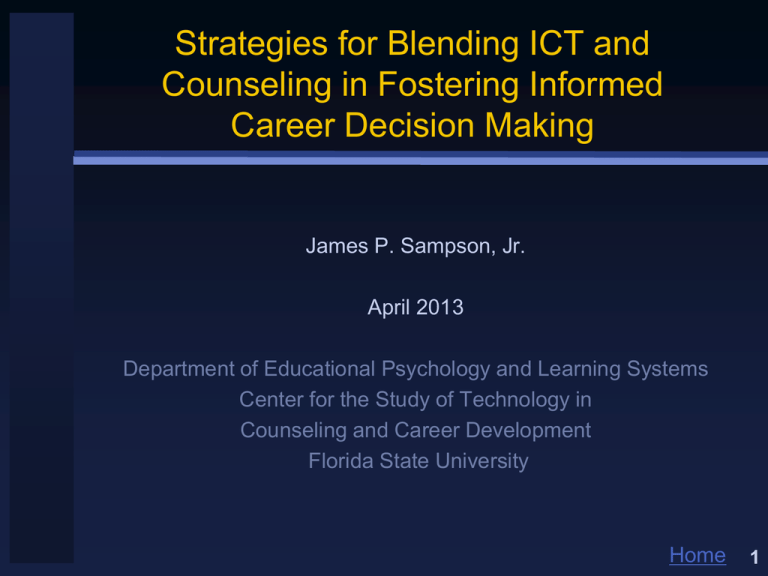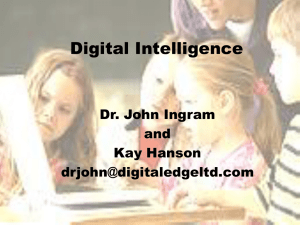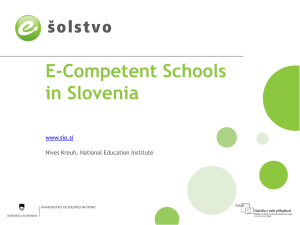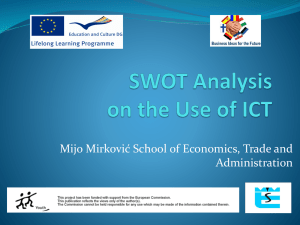Implementing Computer-Assisted Career Guidance
advertisement

Strategies for Blending ICT and Counseling in Fostering Informed Career Decision Making James P. Sampson, Jr. April 2013 Department of Educational Psychology and Learning Systems Center for the Study of Technology in Counseling and Career Development Florida State University Home 1 Introduction • Career interventions aim to promote career growth and development across the lifespan • Career interventions range from providing intensive practitioner support to individuals over time to individuals using self-help resources without practitioner assistance Home 2 Introduction • Information and communication technology (ICT) has become a key element in delivering career interventions • ICT integrates the data processing capacity of computers with the data transmission capacity of digital networks to increase access to career interventions, as well as increase access to career practitioners and other decision makers Home 3 Introduction ICT-based career interventions evolved from the delivery of assessments, information, and instruction on personal computers, to now delivering assessments, information, and instruction on the Internet along with providing services at a distance and social media via the Internet. Home 4 Introduction • Recent advances in the internet have changed the ways in which information is created and disseminated • The internet has evolved from a resource to facilitate communication and disseminate information to the collaborative construction of knowledge using social media and mobile devices Home 5 Introduction • Internet now includes substantial content derived from users • The locus of control in the Internet is shifting from the experts to a blend of expert and user-constructed knowledge Home 6 Introduction Changes in the nature of the Internet increase the potential of ICT to transform the nature of guidance services Home 7 Introduction • Practitioners need to take advantage of the new opportunities afforded by ICT to effectively serve individuals in ways that were not possible in the past • If practitioners are to transform guidance, ICT skill training is essential Home 8 Overview • • • • • • • • • • • Benefits and problems of ICT Role of the practitioner and the role of ICT The influence of practitioners’ scope of practice Career guidance systems Career assessment Career information Distance career counseling Social media, mobile technology, apps, and games Online career centers Blended ICT-based career resources and services Ethical issues and professional standards Home 9 Benefits and Problems of ICT Computer applications in counseling and guidance have always represented an evolving combination of potential benefits and problems. Home 10 Benefits of ICT • The Internet provides increased access to information • Distance service delivery provides increased access to interventions for individuals with disabilities and individuals in remote geographic locations Home 11 Benefits of ICT • The convenience and anonymity of distance service delivery further reduces barriers to access • The Internet makes it easier to locate resources and services to meet specific individuals’ needs as a result of the increasingly powerful search engines Home 12 Benefits of ICT • The interactive and multimedia nature of the internet maximizes the opportunities for learning • Utilizing ICT lowers costs, improves cost-effectiveness, and assists in online recruitment and job search Home 13 Problems of ICT Using ICT in the delivery of career interventions also presents potential problems. • Questionable quality of some career assessments • Questionable quality of some career information Home 14 Problems of ICT • Poor implementation of ICT applications • Questionable confidentiality • Security of some client records • Lack of counselor intervention when it may be needed Home 15 Problems of ICT • Limited evidence of the use of career theory in designing ICT applications • Reduced access for individuals with limited financial resources • Reduced use due to limited digital literacy and advanced age Home 16 Roles of ICT and Role of the Practitioner • ICT and practitioners each have unique and complementary roles in delivering career interventions according to their capabilities • One of the roles of ICT is to perform the repetitive information processing and instructional aspects of career interventions. Home 17 Roles of ICT 1. Test and inventory administration and interpretation 2. Database searches 3. Cross walking among databases 4. Standardized delivery Home 18 Roles of ICT 5. Monitoring progress of the user through the career planning process 6. Delivering instruction 7. Linking to resources Home 19 Roles of ICT Another way to conceptualize the roles of ICT is to focus on specific contributions to the guidance process and to individuals’ career decisions. Home 20 Roles of ICT Barnes, La Gro, and Watts (2010) suggested that ICT may be used for the following four functions: 1) informing (accessing career information) 2) experiencing (learning from virtual online simulations) 3) constructing (understanding their situation using online assessments) 4) communicating (accessing social networks for support and action, wider access to placement or opportunity awareness) Home 21 Roles of ICT Osborn, Dikel, and Sampson (2011) proposed a similar model of three functions: 1) understanding (assist the individual to better understand the nature of his or her problem, i.e., accessing Web-based information to better understand the causes of underemployment) 2) acting (assist the individual to act in ways that helps to solve his or her problem, i.e., accessing a Webbased career portfolio to build an evidence-base of skills to be used in a future job search) Home 22 Roles of ICT 3) coping (assisting the individual to better cope with problems that cannot be completely solved, i.e., accessing social media to communicate with other persons on successful strategies for coping with the frustration of underemployment). Home 23 Roles of the Practitioner • The primary roles of the practitioner in relation to ICT is to assist individuals in selecting, accessing, and using quality ICT applications that are relevant to their needs • Some practitioners may also be involved in designing and systematically examining ICT applications Home 24 Roles of the Practitioner • Practitioners need to monitor individuals’ use of social media • Experience with ICT indicates that practitioner intervention is needed for some individuals Home 25 Roles of the Practitioner • Individuals may not select an ICT application that is best suited to their needs and readiness for career decision making • Some clients need help in selecting and using Internet-based resources Home 26 Roles of the Practitioner It should also be noted that the assessment of readiness for using career interventions is a key element of successful use of a career intervention. Home 27 Roles of the Practitioner • The optimum intervention for some clients involves a combination of counseling and ICT use • Evidence has shown that practitioner intervention with ICT led to positive career development outcomes Home 28 Roles of the Practitioner Models of counseling intervention related to ICT share similar steps Gore, Bobek, Robbins, and Shayne (2006) include three steps in their model: • preparing individuals • monitoring use • processing results Home 29 Roles of the Practitioner Osborn, Dikel, and Sampson (2011) include four steps: • Screening • Recommending – Selecting – Sequencing – Pacing • Orienting • Follow-up Home 30 Roles of the Practitioner Competencies for practitioners using ICT in service delivery include: 1. Knowledge of computer-assisted software and Web sites 2. Capability to diagnose client needs 3. Capability to motivate clients 4. Capability to help clients process data, and 5. Capability to help the client create and implement an action plan. Home 31 The Influence of Scope of Practice and Organizational Support • The nature and extent of a practitioner’s use of ICT in career interventions is strongly influenced by their scope of practice and the support available for ICT integration • Practitioners’ scope of practice is determined by their competencies and whom they serve, as well as how and where that service is provided Home 32 The Influence of Scope of Practice and Organizational Support As a result, some practitioners will make extensive use of ICT in their work, while others will make less use of the range of ICT options available. Home 33 The Influence of Scope of Practice and Organizational Support For example, practitioners working in settings that provide mostly face-to-face individual counseling will use ICT to manage their work, obtain information they need from the Internet, recommend resources for their clients, and communicate with colleagues. Home 34 The Influence of Scope of Practice and Organizational Support • Practitioners in settings where clients are served over wider geographic areas may add distance counseling to their competencies • In settings where there is a mission to serve clients that are less likely to seek traditional office-based services, such as unemployed young people with limited education, practitioners may need to add social media competencies to their ICT competencies Home 35 The Influence of Scope of Practice and Organizational Support Practitioners working in settings that serve a high volume of clients may utilize more Web-based assessment, information, and instructional resources in conjunction with more brief face-to-face interventions in order to meet demand. Home 36 Computer-Assisted Career Guidance Systems A computer-assisted career guidance system, CACGS, includes three components: 1. Assessment 2. Search for options 3. Information delivery Home 37 Computer-Assisted Career Guidance Systems CACGS offer the following specific features: a. on-line chat with a career practitioner b. career videos in English and other languages c. career portfolio d. sharing of data via social media (e.g., LinkedIn, Facebook, and Twitter), e. creation of educational and career plans Home 38 Computer-Assisted Career Guidance Systems f. job placement tools, such as resume builders, interviewing practice, and drafting cover letters and thank you letters g. local job banks and the capacity to research local employers h. exporting important event dates to a calendar Home 39 Computer-Assisted Career Guidance Systems i. supplemental digital publications on various career topics j. calendar reminder for educational and career plans k. technical and training support (phone service, online chat, webinar Home 40 Computer-Assisted Career Guidance Systems • Almost all of these individual elements of CACGS are available online in one form or another • The value of the CACGS is the way that it integrates various elements and provides a coherent and structured learning environment Home 41 Computer-Assisted Career Assessment Computer-assisted career assessment is an important component of the career planning process, and can be used by a client in conjunction with a career practitioner or by an individual seeking online self-help for a career decision. Home 42 Computer-Assisted Career Assessment • Computer-assisted career assessment provides many benefits, including improved integration of the assessments taken, active engagement of clients, fewer errors, and quicker results • Within minutes of completing a career assessment, a client can be provided with a detailed profile of their results that also integrates with multimedia career information Home 43 Computer-Assisted Career Assessment • Other career assessments are available for practitioners only at Vocopher, an online repository of career development resources • It should also be noted that not all instruments that are available online are current, valid, or reliable • Therefore, a key role of the career practitioner is to help clients locate appropriate instruments for their needs Home 44 Computer-Assisted Career Assessment A key application of ICT in assessment is computer-based test interpretation (CBTI) CBTI uses information technology to integrate theory, practitioner judgment, and empirical evidence, as one source of data, to help practitioners and test takers better understand the meaning of test scores for the purpose of gaining insight and making decisions Home 45 Computer-Assisted Career Assessment • The best case scenario is when CBTI is seen in a consultant role, and as one source of information that is integrated with other information about the client by the practitioner • Thus, CBTI has the potential to be of great value to the practitioner as well as the test taker Home 46 Computer-Assisted Career Assessment • Issues can arise when a practitioner relies too much on the CBTI, in effect allowing the report to act as a replacement for the practitioner • Many times, while the career assessment has been validated, information on the validity of the CBTI is limited Home 47 Computer-Assisted Career Information Career information consists of occupational information, educational information, employment information, and job banks. Home 48 Computer-Assisted Career Information At its most basic level, information is data, knowledge or intelligence that is given or received, and may be fact or opinion, valid or invalid, simple or complex, current or outdated, presented in or out of context, biased or unbiased, useful or not useful. Home 49 Computer-Assisted Career Information • The internet, complete with strong search engines, can yield thousands of links to information within seconds of inputting of a term. Not all of this information is equal in quality • Career practitioners have an ethical responsibility to ensure that the information they use with clients is current, and unbiased Home 50 Computer-Assisted Career Information • Career practitioners should be critical evaluators of online information and teach their clients to do the same • Career practitioners are also responsible for determining client readiness to use information, helping determine the sequence when information enters the career counseling process Home 51 Computer-Assisted Career Information • The best known tools for occupational information include the ONET (onetonline.org) and the Occupational Outlook Handbook (bls.gov/oco) • ONET consists of a database of occupations that includes detailed information on job tasks, tools/technology, knowledge, skills, ability, education, interests, work styles, wages, and employment information Home 52 Computer-Assisted Career Information • Education and training information include searchable listings of colleges, universities and training programs • An individual can search listings by program of study, type of institution (i.e., private or public), size, geographical location, student body demographics, tuition rates, and so forth Home 53 Computer-Assisted Career Information • Employment information includes job search information and job vacancy listings • Job search information addresses topics such as creating a resume, writing a cover letter, conducting an interview, negotiating a job offer, using social media to land a job, and creating a comprehensive job search campaign Home 54 Issues Related to Special Populations • Special populations include persons with disabilities, people from diverse groups, sexual minorities, veterans, offenders and the elderly • Most CACGs and career information sites are designed to be used by all populations Home 55 Issues Related to Special Populations However, because of the unique attributes of special populations, online job search information is often presented on websites and job search boards specific to members of these groups. Home 56 Issues Related to Special Populations For example, - diversityemployers.com - hirenetwork.org - aarp.org/work - civilianjobs.com are all examples of sites that provide career information and links to employers who are interested in hiring individuals from these special groups. Home 57 Distance Career Counseling Distance career counseling involves the provision of brief or longer-term individual counseling to clients via the telephone or the web that is often augmented by the use of career assessments and information available on the Internet Home 58 Distance Career Counseling • This particular application of ICT is a major contributor to the increased access to career interventions. Distance service provision has been in existence for some time in the form of telephone help lines • Over time there has been an increasing use of the telephone for in-depth career intervention as opposed to information provision • Evidence of effectiveness is increasing Home 59 Social Media Social media, applications (apps) and online games have expanded the possibilities of career counseling information and interventions. Home 60 Social Media With millions of people using social media such as Facebook, Twitter, LinkedIn, Instagram, and others, career practitioners are exploring how to incorporate these venues into career service delivery. Home 61 Social Media • Many career centers have increased their use of social media, such as Facebook, Twitter and LinkedIn, as a way to share information with students • Other possible tools might include blogs, discussion forums, and chatting features for sharing career information Home 62 Mobile Technology • With the advent of smart phones, blackberries, and tablets came application software or “apps” • Some apps such as Unstuck, DecideNow, and iThoughtsHD may have application in career counseling Home 63 Mobile Technology • Mobile technologies also provide potentially useful tools for the career practitioner within their hardware • For example, the video camera on a tablet could record a mock interview and then be sent to the client, or shared through a filesharing app such as google drive or dropbox Home 64 Mobile Technology Many career websites, such as the online Occupational Outlook Handbook, have mobile apps that allow clients to research on their mobile device. Home 65 Games Career practitioners have used games such as card sorts, the Holland Party Game or the Real Game in face-toface counseling. Home 66 Games • Three online career games include realgame.com, driveofyourlife.org, and SIMS3: Ambitions • These games engage individuals in assessing their interests and exploring options by linking those activities to achieving game objectives Home 67 Online Career Centers An online career center provides internet-based resources and links to other relevant internet sites for individuals making career choices, with career practitioner support provided for those who need assistance. Home 68 Online Career Centers • Online career center can increase clients’ access and remove the space limitations that occur in conventional career libraries • Online career centers can be developed at a relatively low cost and are relatively easy to adapt to a particular situation Home 69 Blended ICT-Based Career Resources and Services The potentially greatest gains in using ICT resources occur when applications are blended in meaningful ways. Home 70 Blended ICT-Based Career Resources and Services • The most common form of integration involves practitioners providing assistance to individuals in need in a timely manner • Practitioners can assist individuals in the “teachable moment” while they are using a career resource Home 71 Blended ICT-Based Career Resources and Services • In this way, practitioners can help individuals immediately process and apply what they are learning from using a resource to a career problem Home 72 Ethical Issues and Professional Standards The exponential availability of technological resources has raised many ethical concerns. Ethical standards that exist for face-to-face counseling also apply to distance counseling, although the venue of service delivery might require some adjustment of these standards. Home 73 Ethical Issues and Professional Standards Career practitioners using the Internet to provide services must also learn how to deliver these services in an effective manner within these new contexts while being aware of credentialing and licensure issues when providing services across state lines. Home 74 Conclusion • ICT can act not only as a tool but potentially acting as an agent of change in the ways in which we conceptualize and deliver career • This view continues just as true today Home 75 Reference • Sampson, Jr., J. P., & Osborn, D. S. (submitted 2013). Using information and communication technology in delivering career interventions. In P. J. Hartung, M. L. Savickas, & W. B. Walsh, (Eds). APA handbook of career intervention. Washington, DC: American Psychological Association. Home 76






